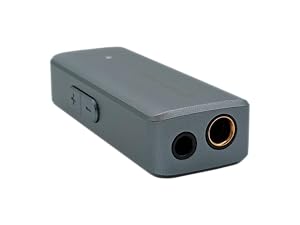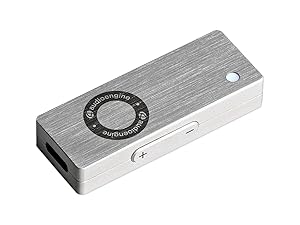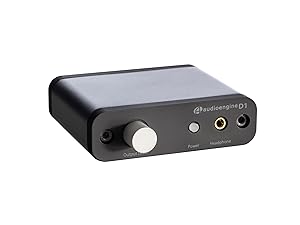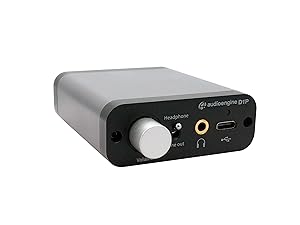Customer Services
Copyright © 2025 Desertcart Holdings Limited
Desert Online General Trading LLC
Dubai, United Arab Emirates







🎶 Unleash Your Audio Potential!
The Audioengine D1 is a high-performance 32-bit desktop DAC and headphone amplifier that delivers exceptional sound quality for both gamers and musicians. Its compact design and dual audio modes make it a versatile addition to any workspace, ensuring you can enjoy private listening or share your audio effortlessly.






G**L
Fantastic DAC and fair cost given the brand and build-quality
This is a very preliminary review, but I think it's still worth providing to help others.First, when I was reviewing the product info, it said it was plastic. I thought that was kinda whack given the cost and the quality of my Audioengine A5 speakers. However, upon opening the amazingly-well packaged box, it turns out most of the DAC is really metal, even the volume knob is metal. The only plastic on the outside is the edges of the box (the black in the picture; the grey is metal) and the power button.Like I said, this was very well packaged. It shipped in an Audioengine box, but a branded shipping box: inside was another box for the DAC. That box in and of itself could've survived shipping, but I appreciate that it was double boxed. Inside the DAC box was a nice piece of soft foam, and the components were snuggled inside heavier duty foam. (I don't know what the different types are called, but this isn't your typical white styrofoam like for a cooler). It also includes a carrying bag if you wanted to travel with the DAC, but the bag would mostly just protect against scratches. However, given the metal construction, I don't think you need much more than that.Setup was super easy once I realized I made a mistake: I kept thinking I needed two USB cords, one for audio input (I have optical out, but not a cable) and one for power. No, the USB cord, which is included, provides both power and audio. I was looking at picture in the manual thinking it was the front telling me that's where the USB audio input was, but after I double-checked, that was really the back of the DAC, then I read it closer and realized my mistake. It was 100% my fault. I write user manuals for a living so I can say with confidence this is one of the best I've encountered. I just didn't drink enough coffee.Compatibility: it works with my Audioengine A5s with no problem, which is part of the reason I bought this DAC. Yes, it has other great reviews, and, yes, my speakers are the bomb dot com, but having no doubts that it would work before it even arrived gave me peace of mind.To my untrained ear, everything sounds fantastic. I mostly stream music, and it sounds fantastic. I'll see what my music teacher/musician wife thinks, but she'll most definitely agree. I should note that I don't have a subwoofer, but whether it's the speakers or the DAC, the music still sounds fine. I'll put it through the paces gaming at another time, but I can't imagine anything would be different.Now, when I write my reviews, I try my best to not just gush over how great everything is so it doesn't appear as though my review is fake or paid for. The only thing I can think of from only having used the product probably no more than an hour is that I wish more cables were included. It's nice that it comes with a USB cord, but I had to dig through my box of cables for an RCA cable, and I'm not sure I even know what an optical cable looks like to see if I have one of those. I do understand the choice not to include these things because everyone's setup is different, and it minimizes waste, but it still would've been nice. I'm not deducting stars, however, because of a lack of cables. This is still a 5-star product.
A**.
Great sound, drives high impedance headphones with a good volume, no drivers required
The amplifier is rather tiny, but creates a big sound. I used it with Sennheiser HD-600 high impedance (350 Ohm-cm) reference headphones, as well as Sony WH1000XM4 noise cancelling headphones, but Sony headphones sound so distinctly worse than Sennheiser with a good quality headphones amplifier.... There is no comparison. The sound was very sweet and balance right out of the box. There is a (never ending) discussion about burn-in of audio equipment, even though there is not much, if any at all, data confirming that such thing as burn-in even exists. I actually think that mechanical parts of headphones may break in and headphones, if new, may sound better after some hours, but I cannot explain why transistors would change in any way. Anyhow, the manual recommends an up to 50 hours burn-in. I put together a very simple 30 Ohm per channel passive load to use instead of headphones, and played music into this passive load for two days. I did not notice any difference at all after this burn-in compared to "out of the box" sound. Plenty of power to drive HD-600. As an experiment, I plugged in a Creek headphones amplifier into line out of the motherboard, and sound was quite unpleasant, Audioengine D1 sounds way, way better! I also tested the sound with a setup with Audioengine D1 converting digital signal to analogue, and then connected Creek to Audioengine via RCA stereo cable. I found that base was a little cleaner and punchier with the Creek, but overall they were close, and this confirms that the analogue part of Audioengine D1 is also well designed. I am very happy with this purchase, HUGE improvement compared with sound directly from the computer headphones jack or motherboard line out. Of course high quality headset is a must to hear the difference. Very well packaged, nice box which projects quality. A small but good manual (although who reads it, the operation of this little unit is self-evident). I rally like it and happy with this purchase, an excellent value for the money! I need to mix some piano recordings in my home studio, and this amp will be of huge help. I'd say, it sounds cleaner and better than amp in Focusrite Scarlette and Clarette interfaces which I used until now.
Trustpilot
1 week ago
2 weeks ago